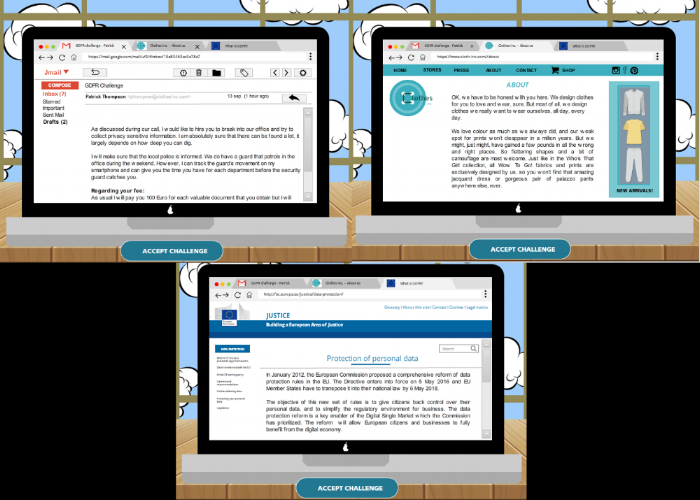Gamification: How to? Part I: Relatedness
Context
After writing three theoretical blogposts about Gamification I could not wait to have a go at designing a gamification learning solution myself. In prospect of the bi-annual VOV fair, the biggest L&D conference in Belgium, our team wanted to create a blended learning solution based on our very own aXles-model.
We chose the new European General Data Protection Regulation (GDPR) law as our business case and as main objective we wanted to create and increase awareness of the impact of GDPR on organisations. In our aXles model, my gamified e-learning module can be situated in eXperience while my colleagues would create content for eXplain and eXpose. For more information on how we mapped our objective to the aXles model and GDPR topic, please click here.
In what follows I will try to explain and illustrate my approach by elaborating on the game mechanics that I found crucial. Before I do so, it is important that you know:
- The gamified content does not require prior knowledge of the GDPR law or privacy sensitive information in general.
- As I pointed out in my blog ‘What is Gamification?’, you don’t need to create a full offline or online game to call it a gamified learning solution. The main aspect of this L&D tool, is that you design and apply game-like elements. However, our chosen approach to create multiple solutions and the fact that learners do not need to have prior knowledge gave me the perfect ground to create a ‘full game’ that serves both the ‘create awareness’ and ‘challenging & fun’ objectives.
Mind Mapping Ideas
How to start? I simply wrote down from my own experience: everything I love and hate regarding games so that I could identify the essential elements. I’ve also read a lot about gamification for my earlier blogposts.
From that literature, the three factors (Relatedness, Autonomy, Competence) from the Self Determination Theory that serve intrinsic motivation caught my interest the most. It did not take long to come to the following preferred game mechanics:
- Identification
- Storytelling
- Basic but challenging game objective
- Freedom (to explore, choose, solve solutions, fail, receive feedback)
Creating Relatedness: Identification & Storytelling
Starting point for the gamified learning solution: a somewhat desperate CEO tries to create support in his organisation to accept that the new GDPR law will be a challenge for the entire organisation. However as the saying “culture eats strategy for breakfast” goes, a lot of the employees refuse to believe that they work with privacy sensitive information in their role.
As a result, the frustrated CEO wants to shock his employees and create awareness by hiring a befriended white hat hacker (i.e. you as the player!). It will be your job to break into the office to search and collect as many privacy sensitive information possible. Let the games begin! 😊
Above you see the first three screens that you will go through as the player. After choosing an Avatar, you fill out your name. These two personalized features will return at certain points in the challenge.
Once started, you’re immediately dropped in the story where you get a video call from the CEO that is lip synced with my voice over.
Tip: Have an eye for details that could reinforce your storyline. For our business case, we created a fictional fashion company called Clothes Inc., we created a logo and integrated a company website in the game should the learner feel the need to explore the company’s background.
As this was an internal Arboth project we opted for a fictional company but this game could very well be designed bearing your company and its departments in mind. It would only increase relatedness and you could make use of GDPR law cases that are specific to your business role.
Stay tuned for Gamification: How to? Part 2: Competence that will be published very soon. In this part, you will see how we matched the learning goals of this project with the game objectives!

